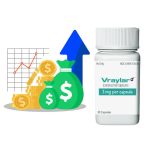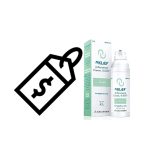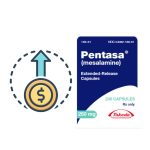Why is Vyzulta So Expensive?

Vyzulta is a brand-name prescription medication used to lower intraocular pressure (IOP) in patients with open-angle glaucoma or ocular hypertension. It contains the active ingredient latanoprostene bunod, which is a prostaglandin analog and nitric oxide (NO) donator.
Vyzulta works by reducing intraocular pressure through two mechanisms. First, it increases the outflow of aqueous humor, the fluid inside the eye, through the uveoscleral pathway. Second, it releases nitric oxide (NO) within the eye, which further enhances the outflow of fluid through the trabecular meshwork, another pathway for draining aqueous humor.
The medication is indicated for the reduction of intraocular pressure in patients with open-angle glaucoma or ocular hypertension. Elevated intraocular pressure is a major risk factor for the development and progression of glaucoma, a group of eye conditions that can lead to optic nerve damage and vision loss if left untreated.
Vyzulta is administered as an ophthalmic solution, which is instilled into the affected eye(s) once daily in the evening. The medication comes in a single-use, sterile, preservative-free container to prevent contamination and ensure proper dosing. Clinical studies have demonstrated the efficacy of Vyzulta in reducing intraocular pressure. In pivotal trials, Vyzulta was shown to significantly lower IOP compared to placebo and other prostaglandin analogs. Lowering intraocular pressure helps to reduce the risk of optic nerve damage and slow the progression of glaucoma.
However, as with many brand-name medications, Vyzulta can be expensive. The cost for Vyzulta ophthalmic solution 0.024% is around $278 for a supply of 2.5 milliliters. The cost may vary depending on factors such as insurance coverage, pharmacy discounts, and geographic location.
Why is Vyzulta So Expensive?
The cost of Vyzulta, like many brand-name medications, can be attributed to various factors within the pharmaceutical industry and healthcare system including:
1. Research and Development Costs: Developing a new medication involves significant investment in research, development, and clinical trials. Pharmaceutical companies incur substantial expenses to discover and test new drugs, including investments in scientific research, preclinical studies, and multiple phases of clinical trials to demonstrate safety and efficacy. These research and development (R&D) costs are factored into the pricing of Vyzulta and other brand-name medications to recoup investments and fund future innovation.
2. Patent Protection: Pharmaceutical companies obtain patents to protect their investment in developing new medications and gain exclusive rights to manufacture and sell the drug for a certain period, typically 20 years from the date of filing. During this time, competitors are barred from producing generic versions of the medication, allowing the patent holder to set prices at higher levels to maximize revenue. The exclusivity provided by patents enables companies to charge premium prices for brand-name drugs like Vyzulta.
3. Limited Competition: Vyzulta belongs to a class of medications known as prostaglandin analogs, which are commonly used to lower intraocular pressure in patients with glaucoma or ocular hypertension. While there are several other prostaglandin analogs available on the market, including latanoprost and bimatoprost, Vyzulta’s unique formulation as a nitric oxide donator sets it apart from other options. Limited competition in the specific niche of prostaglandin analogs with nitric oxide-donating properties allows the manufacturer of Vyzulta to maintain higher prices without significant downward pressure from generic alternatives.
4. Manufacturing Costs: The production of pharmaceuticals involves complex manufacturing processes, quality control measures, and adherence to regulatory standards set by health authorities. Specialized equipment, facilities, and expertise are required to manufacture ophthalmic solutions like Vyzulta in a sterile and controlled environment. These manufacturing costs contribute to the overall expense of producing Vyzulta and are reflected in its pricing.
5. Marketing and Distribution Expenses: Pharmaceutical companies invest significant resources in marketing, promotion, and distribution to raise awareness of their medications among healthcare providers and patients. Marketing campaigns, sales representatives, educational materials, and distribution networks incur additional costs, which are passed on to consumers through the pricing of Vyzulta.
6. Insurance Coverage and Healthcare System Dynamics: The negotiation and reimbursement policies of insurance companies, pharmacy benefit managers (PBMs), and government healthcare programs can influence the cost of medications like Vyzulta for patients. Formulary placement, copayments, and coverage restrictions imposed by payers may impact patient access and out-of-pocket expenses. Additionally, healthcare system dynamics, including drug pricing regulations, market dynamics, and healthcare provider reimbursement models, can affect the pricing of Vyzulta and other pharmaceuticals.
Overall, the high cost of Vyzulta is influenced by a combination of factors, including research and development costs, patent protection, limited competition, manufacturing expenses, marketing and distribution efforts, and healthcare system dynamics. While these factors contribute to the expense of brand-name medications like Vyzulta, patients may explore alternative treatment options, insurance coverage, or financial assistance programs to help manage the cost of their medication.
Can I get a cheaper Vyzulta?
Obtaining Vyzulta at a lower cost can be challenging due to its status as a brand-name medication and the limited availability of generic alternatives. However, there are several strategies you can explore to potentially reduce the financial burden of Vyzulta:
1. Insurance Coverage Review: Review your health insurance plan’s coverage for Vyzulta. Some insurance plans may offer partial coverage for prescription medications, including Vyzulta. Contact your insurance provider to understand the extent of coverage provided, any copayments or deductibles applicable, and whether Vyzulta is included in your plan’s formulary. You may also consider switching to a different insurance plan that offers more favorable coverage for Vyzulta if feasible.
2. Patient Assistance Programs: Pharmaceutical companies that manufacture Vyzulta may offer patient assistance programs or copay assistance programs to eligible individuals. These programs provide financial assistance or discounts on prescription medications for patients who meet certain income criteria or lack adequate insurance coverage. Contact the manufacturer of Vyzulta or visit their website to inquire about available patient assistance programs and eligibility requirements.
3. Prescription Savings Cards: Pharmacy discount cards or prescription savings cards can help reduce the cost of Vyzulta and other prescription medications. These cards are typically available for free and can be used at participating pharmacies to obtain discounts on the retail price of medications. Websites such as GoodRx and RxSaver offer prescription savings cards that can be used for Vyzulta and other medications.
4. Mail-Order Pharmacies: Some mail-order pharmacies offer discounted prices on prescription medications, including Vyzulta. By purchasing Vyzulta through a mail-order pharmacy, you may be able to obtain it at a lower cost compared to purchasing it from a retail pharmacy. Additionally, mail-order pharmacies may offer convenience and the option to receive a larger supply of medication at one time.
5. Manufacturer Coupons or Rebates: Check the manufacturer’s website or contact them directly to inquire about any available coupons, rebates, or special offers for Vyzulta. Manufacturers may periodically offer discounts or promotional deals to help offset the cost of prescription medications for patients.
6. Discuss with Your Healthcare Provider: If cost is a concern, discuss your financial situation with your healthcare provider. They may be able to recommend alternative treatment options, dosage adjustments, or therapeutic substitutions that are more affordable while still effectively managing your condition. Your healthcare provider can also provide guidance on accessing financial assistance programs and navigating insurance coverage issues.
By exploring these strategies and working with your healthcare provider and pharmacist, you may be able to obtain Vyzulta at a more affordable rate while still effectively managing your condition. Additionally, don’t hesitate to discuss any concerns or financial constraints with your healthcare provider to explore alternative treatment options or cost-saving strategies.





